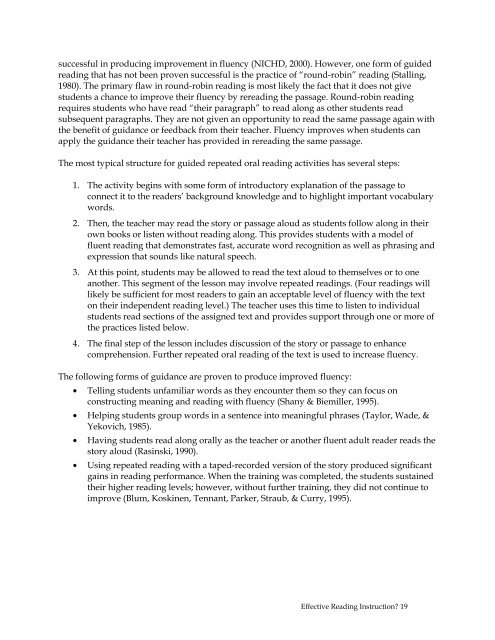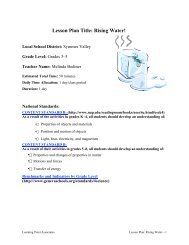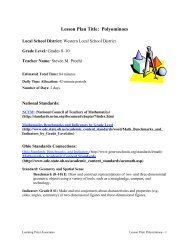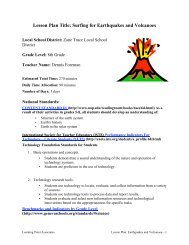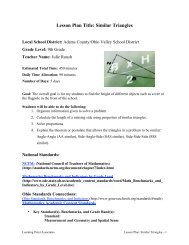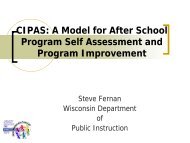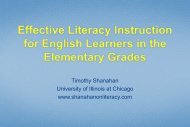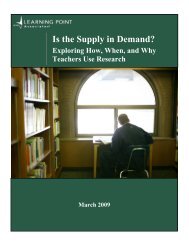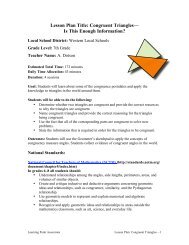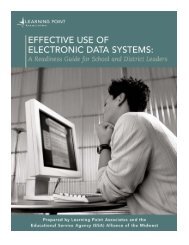A Closer Look at the Five Essential Components - Learning Point ...
A Closer Look at the Five Essential Components - Learning Point ...
A Closer Look at the Five Essential Components - Learning Point ...
You also want an ePaper? Increase the reach of your titles
YUMPU automatically turns print PDFs into web optimized ePapers that Google loves.
successful in producing improvement in fluency (NICHD, 2000). However, one form of guided<br />
reading th<strong>at</strong> has not been proven successful is <strong>the</strong> practice of “round-robin” reading (Stalling,<br />
1980). The primary flaw in round-robin reading is most likely <strong>the</strong> fact th<strong>at</strong> it does not give<br />
students a chance to improve <strong>the</strong>ir fluency by rereading <strong>the</strong> passage. Round-robin reading<br />
requires students who have read “<strong>the</strong>ir paragraph” to read along as o<strong>the</strong>r students read<br />
subsequent paragraphs. They are not given an opportunity to read <strong>the</strong> same passage again with<br />
<strong>the</strong> benefit of guidance or feedback from <strong>the</strong>ir teacher. Fluency improves when students can<br />
apply <strong>the</strong> guidance <strong>the</strong>ir teacher has provided in rereading <strong>the</strong> same passage.<br />
The most typical structure for guided repe<strong>at</strong>ed oral reading activities has several steps:<br />
1. The activity begins with some form of introductory explan<strong>at</strong>ion of <strong>the</strong> passage to<br />
connect it to <strong>the</strong> readers’ background knowledge and to highlight important vocabulary<br />
words.<br />
2. Then, <strong>the</strong> teacher may read <strong>the</strong> story or passage aloud as students follow along in <strong>the</strong>ir<br />
own books or listen without reading along. This provides students with a model of<br />
fluent reading th<strong>at</strong> demonstr<strong>at</strong>es fast, accur<strong>at</strong>e word recognition as well as phrasing and<br />
expression th<strong>at</strong> sounds like n<strong>at</strong>ural speech.<br />
3. At this point, students may be allowed to read <strong>the</strong> text aloud to <strong>the</strong>mselves or to one<br />
ano<strong>the</strong>r. This segment of <strong>the</strong> lesson may involve repe<strong>at</strong>ed readings. (Four readings will<br />
likely be sufficient for most readers to gain an acceptable level of fluency with <strong>the</strong> text<br />
on <strong>the</strong>ir independent reading level.) The teacher uses this time to listen to individual<br />
students read sections of <strong>the</strong> assigned text and provides support through one or more of<br />
<strong>the</strong> practices listed below.<br />
4. The final step of <strong>the</strong> lesson includes discussion of <strong>the</strong> story or passage to enhance<br />
comprehension. Fur<strong>the</strong>r repe<strong>at</strong>ed oral reading of <strong>the</strong> text is used to increase fluency.<br />
The following forms of guidance are proven to produce improved fluency:<br />
• Telling students unfamiliar words as <strong>the</strong>y encounter <strong>the</strong>m so <strong>the</strong>y can focus on<br />
constructing meaning and reading with fluency (Shany & Biemiller, 1995).<br />
• Helping students group words in a sentence into meaningful phrases (Taylor, Wade, &<br />
Yekovich, 1985).<br />
• Having students read along orally as <strong>the</strong> teacher or ano<strong>the</strong>r fluent adult reader reads <strong>the</strong><br />
story aloud (Rasinski, 1990).<br />
• Using repe<strong>at</strong>ed reading with a taped-recorded version of <strong>the</strong> story produced significant<br />
gains in reading performance. When <strong>the</strong> training was completed, <strong>the</strong> students sustained<br />
<strong>the</strong>ir higher reading levels; however, without fur<strong>the</strong>r training, <strong>the</strong>y did not continue to<br />
improve (Blum, Koskinen, Tennant, Parker, Straub, & Curry, 1995).<br />
Effective Reading Instruction? 19


